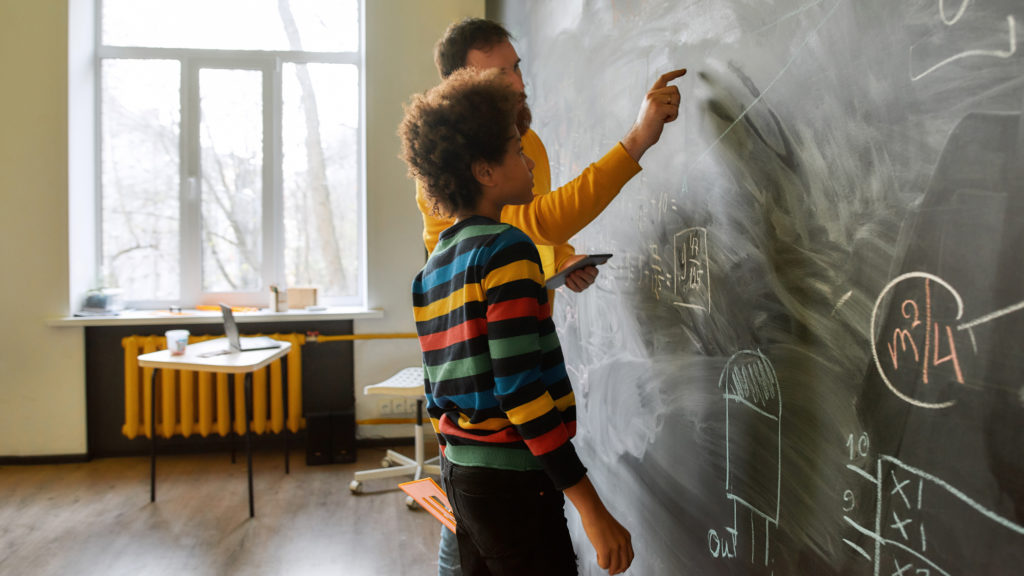
There are many factors that come into play in determining the quality of your child’s education…
…but one thing that many parents overlook is the student-teacher ratio.
The quality of your child’s early education will have a significant impact on his future.
Unfortunately, some schools simply do not have the money it takes to give each child the degree of quality education they deserve. Schools all over the country are led by teachers who are burned out from classrooms that are too full and budgets that are too small.
But how important is the student-teacher ratio?
And is there a way you can offset the damage of an over-crowded classroom by supplementing your child’s education at home?
Keep reading to find out.
What is the Student-Teacher Ratio?
According to the glossary of education reform, the student-teacher ratio “expresses the relationship between the number of students enrolled in a school…
…and the number of full-time equivalent teachers employed by the school.
To give you an example, a school that has a 10:1 student-teacher ratio would have ten times as many students as full-time teachers.
The student-teacher ratio is important for a number of reasons.
For one thing, it can be used as a tool to measure teacher workload as well as the allocation of resources, particularly in public schools.
More importantly, however, it can be an indicator of the amount of individual attention any single child is likely to receive, keeping in mind that not all class sizes are going to be the same.
The student-teacher ratio of any given school or school district is frequently used to judge the quality education. It is important to note, however, that the “ideal” student-teacher ratio will vary depending on a few different factors.
Among other things, you have to consider the age of the students as well as their academic needs.
For example, younger students and students who have learning challenges require more time and individual attention from teachers. Therefore, the ideal student-teacher ratio for these children would be higher than for older children.
You also have to factor in the skills, experience, and efficacy of the specific teachers, because they are not all equal. A more highly skilled and experienced teacher, for example, might be able to handle a larger class than one less experienced.
How Have Student-Teacher Ratios Changed?
Over the past few decades, the state of the education system in the United States has changed dramatically. At both state and federal levels there has been a great deal of reform when it comes to educational strategies and school initiatives.
For example, there has been a push toward decreasing student-teacher ratios across the board in the hopes of improving the academic performance of school-age children.
The idea behind this reform is one that has already been mentioned – the idea that teachers who have fewer students in their classrooms will be able to spend more time with individual students. The more individual attention a student receives, then, the more his learning improves and the higher his chances for academic success become.
In order to achieve lower student-teacher ratios, many schools have begun to hire additional support staff, not just additional teachers. Schools have also begun to change their instructional strategies to achieve the same goals as lower student-teacher ratios but through a different means.
For example, some schools have begun to group students with similar academic skill levels into small learning communities.
With this type of instructional strategy, one teacher or support specialist can get to know each student’s individual needs more quickly than in a large classroom which means that they are better able to provide for the individual needs of students

Facts and Statistics About Class Size and Student Achievement
Now that you understand what student-teacher ratio is and how it might affect your child’s academic performance, you may be interested to learn about some research findings related to the subject. Here are some interesting facts and statistics linking class size and student achievement:
- In grades K-3, smaller class sizes of no more than 18 students per teacher showed the greatest academic achievement levels.
- When placed in smaller class sizes in primary grades, minority and low-income students showed the greatest gains.
- Reducing class size has little positive effect without an adequate number of classrooms and without enough well-qualified teachers.
- Professional development opportunities for teachers (like rigorous curriculum and professional development) help to improve the effect of reduced class sizes on the academic achievement of K-3 students.
- Reduced class size initiatives tend to fail when the class size is set to 20 students or more or when it is implemented unevenly or for the short term.
- The more years a student spends in reduced class sizes, the longer the benefits last.
By now it should be clear to you that the student-teacher ratio in your child’s classroom (and in his school in general) can have a serious impact on his learning and his academic performance. If you are worried that the student-teacher ratio in your child’s class is too high, there are things you can do at home to help make sure that he is learning at the appropriate speed.

How to Supplement Your Child’s Education at Home
Supplementing your child’s education at home is not as complicated or time-consuming as you might imagine – you don’t even have to be an expert in each of the subjects your child is learning. If you want to make sure that your child is learning at the right speed, try some of these simple tips at home:
- Create a schedule for school nights that gives your child some time to unwind after school but still complete homework before bedtime.
- Make sure your child has a healthy environment for doing homework without distractions – he needs no TV, plenty of space to spread out, and proximity to you so he can ask for help.
- Don’t hover while your child is doing his homework – be available to provide help when asked and check over the assignment once he’s finished.
- If your child is struggling with a concept, don’t do the work for him! Go over the assignment together and refer to other classroom materials that might be relevant until your child understands.
- Reach out to your child’s teacher if you are worried that he is falling behind – the teacher might be able to give you some tips to help your child at home or might provide some extra materials that you can use to support your child at home.
- Encourage your child to learn and explore new things outside of the classroom – take educational trips on the weekend and promote reading as a fun downtime activity.
Every parent wants what is best for their child, especially when it comes to education.
It is unfortunate but true that some children are at an educational disadvantage just because of where they live. Some schools receive more monetary resources and are more appealing to teachers who have more experience.
If you are worried about your child falling behind academically, stand up and fight for improvements to the school system in your area.
You can also make a difference in your child’s life by helping him to learn at home.

